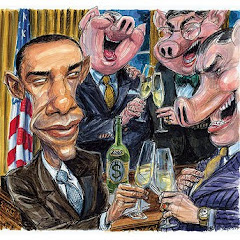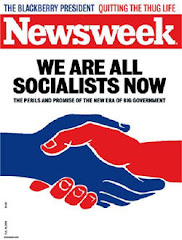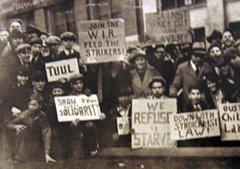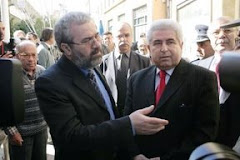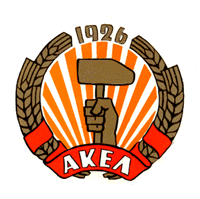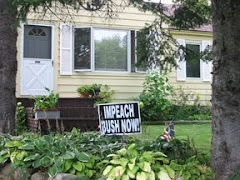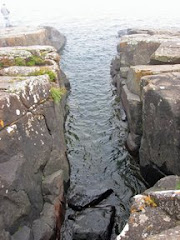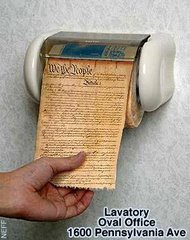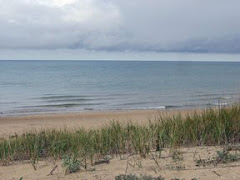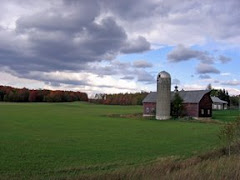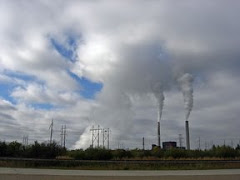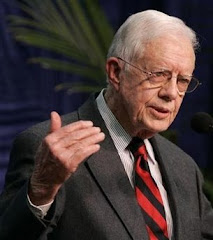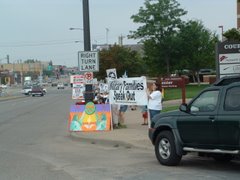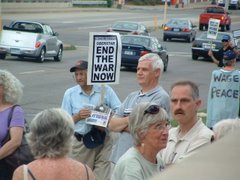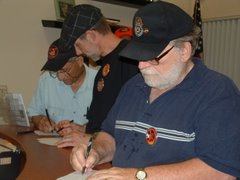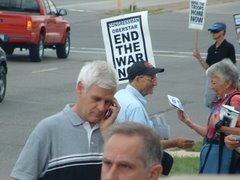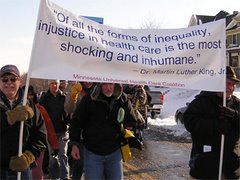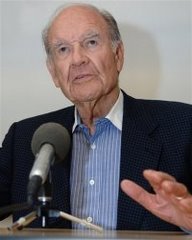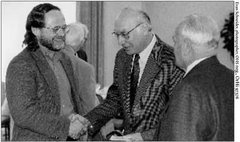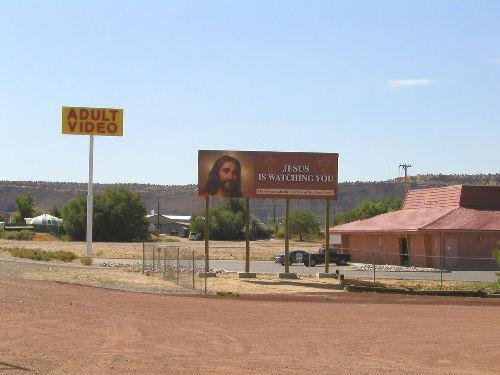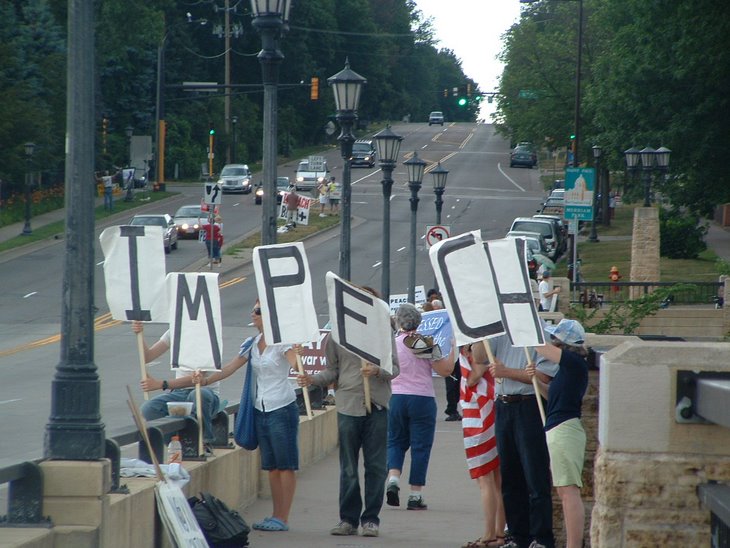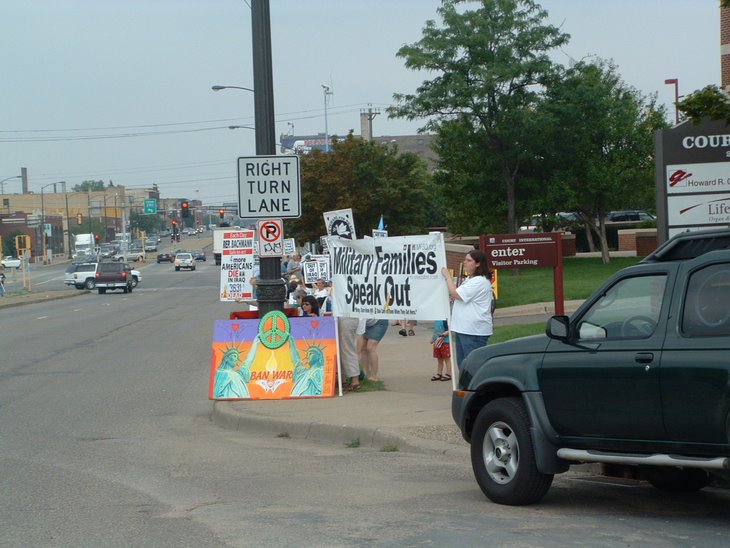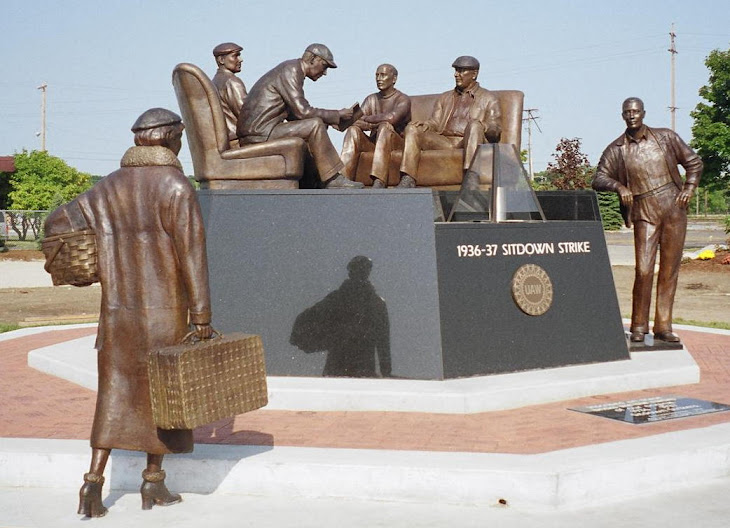
Union leaders and activists from around the world will be convening a conference--- A North American Labor Assembly on Climate Crisis: Building a Global Movement for Clean Energy

Click on the title [with the white arrow set in a small orange box] to check it out.
I hope our proposal to save the St. Paul Ford Assembly Plant will be discussed at this conference.
Appeal To Minnesotans For Public Ownership Of The Ford Plant
By:
Alan Maki Of Save Our Bog

And
Christine Frank Of The Climate Crisis Coalition Of The Twin Cities
Christine Frank (on right) with Minnesota State Legislator Bill Hilty and wife Laurie

[Aerial view of St. Paul, Minnesota Ford Twin Cities Assembly Plant]

The HISTORY OF THE FORD PLANT
As we are all too painfully aware, Ford’s Twin Cities Assembly Plant is slated to close in 2008. The economic and environmental consequences affect everyone in the state, and for that reason, a concerted effort should be made to keep it open. Yet, city, county and state officials are throwing up their hands and helplessly accepting the situation as a fait accompli. It was the promise of cheap hydroelectric power that prompted Henry Ford to build an automotive assembly plant in St. Paul. The initial dam on the Mississippi River was completed in 1917 by the U.S. Army Corps of Engineers, the plant went up in 1924 and a major upgrade was finished on the dam in 1929 for the benefit of the automaker. The St. Paul facility is the oldest Ford plant in operation, and to this day, is still run by renewable hydropower, which is to the benefit of the surrounding community and the natural environment. The onsite availability of high-quality sandstone, making it possible to produce windshield and lamp glass, was another feature that attracted Ford to the area.
The plant first made Model As & Ts. Later, with the advent of World War II, the U.S. witnessed one of the greatest crash militarization programs ever undertaken, and Ford wasted no time in retooling for military production. The plant in St. Paul made T17 armored cars used by the British army and U.S. military police and M8 howitzers, which were light tanks. Local autoworkers also did precision machining on pistons, cam supports and pump gears for Pratt & Whitney aircraft engines. This enabled war profiteer Henry Ford to make money hand over fist. Being blatantly anti-Semitic and pro-fascist, he produced equipment for both the U.S. Army and the German Wehrmacht in his American & European facilities. The main lesson here is that in its 82 years of operation, the local Ford plant has been retooled many times, producing over 20 different model vehicles for peace- and wartime purposes. There is no reason why this cannot be done again for the good of the community.
THE ECONOMIC NECESSITY OF SAVING JOBS
In the face of increased competition from foreign automakers and in the interests of the bottom line, Ford’s president and board of directors have made a conscious decision to divest capital in areas they deem unprofitable and reinvest elsewhere. This is at the cost of 30,000 jobs nationwide. The St. Paul factory is one of the strongest components of what remains of Minnesota’s industrial base.

Its 1,885 hourly & salaried employees, who have given many years of loyal service, along with their families need the jobs, benefits and pensions that have been promised to them. The wages they earn are a vital part of the economy. If the plant closes and they do not have the opportunity to transfer to another Ford facility, they will lose everything. Plus, future generations will never have the chance to work at these good-paying, productive jobs because they will be gone forever. Turning the land over to the highest bidder for development is not the answer either because that will only make a wealthy few richer in the long run. These jobs must be saved to prevent the members of UAW 879 from being thrown onto the scrap heap.
THE ECOLOGICAL NECESSITY OF KEEPING THE FORD PLANT OPEN
With global warming and climate change threatening Earth with ecological disaster, we must take measures to reduce greenhouse gas emissions in every aspect of our lives. This includes transport. We can no longer afford to get from Point A to B in private automobiles. The vast quantities of materials used and waste stream generated are taxing the planet’s finite resources beyond sustainable limits. With only ten years left to put things right, producing hybrids at this point is not enough. In fact, it is a case of too little, too late. If the automakers had begun manufacturing them in the early ‘70s when carbon dioxide concentrations really spiked, then we might have something to show for it now, but that is not the case.
The use of E85s powered by ethanol are problematic as well. Ethanol is a hydrocarbon whose production wastes grains needed for food and creates air pollutants and whose burning adds to CO2 concentrations. Therefore, we must convert immediately to clean mass transit systems powered by renewable energy. Given its past history, St. Paul’s Ford Plant could easily be retooled for the production of electric train engines and carriages that are driven by green wind & solar power. Just imagine convenient and efficient rail systems criss-crossing the entire country carrying passengers and freight and what an aid that would be to Earth’s ecosystems.
INSTEAD OF THE BOTTOM LINE, LET’S TALK ABOUT THE POLITICS AND ECONOMICS OF WORKERS’ LIVELIHOODS FOR A CHANGE.
PUBLIC OWNERSHIP IS THE ANSWER
The auto-makers and other Carbon Barons are largely to blame for the dilemma we are in. It was they who destroyed the electric street car systems in the early 20th century in order to build more roads, sell more automobiles and burn more fossil fuels. This proves that they do not run their operations with the welfare of the planet or the rest of us in mind. If Ford’s management and stockholders are unwilling to keep the plant open for either clean or dirty transport, then let’s put it under public ownership. It is not unheard of. The Manitoba provincial government took over the Ford tractor factory in Winnipeg in order to prevent its closing. Let’s go them one better by using a green-powered plant to produce environmentally-friendly mass transit for the health of the planet and us human beings. Being some of the most progressive and ecologically-minded union members in the state, the leaders and ranks of UAW 879 would no doubt be proud to work in such a plant and support this campaign.
HOW WILL WE PAY FOR IT?
We should keep in mind that Ford Motor Company has made billions from war profiteering, government bailouts and subsidies and tax breaks. Being granted its own hydroelectric power is a perfect example of the free ride Ford has gotten. That dam, for all practical purposes, belongs to the community and generates 5 mWh of excess electricity that is sold to Xcel for $4 million a year so, in a sense, the operation already helps pay for itself. In order to make money available to purchase the factory, we can end state-funded corporate boondoggles and development schemes that benefit only the rich, demand that less money be spent for war and more for jobs & the environment, tax corporate polluters and halt waste on every level by reducing, reusing and recycling at the point of production.



In fact, there are many creative ways the project could be funded that are financially sound and ecological—including increasing the taconite tax since keeping the St. Paul Ford plant operating will save mining jobs on the Iron Range too.

It is merely a matter of redirecting our priorities and asserting our societal will. So let’s join together to achieve a worthy goal--retool the Ford plant to produce green mass transit and not only save Minnesota jobs but ultimately Earth!
REAL JOBS at REAL LIVING WAGES !
SAVE THE ST. PAUL FORD ASSEMBLY PLANT !
THE SOLUTION IS PUBLIC OWNERSHIP !
*************
A joint venture with the Chinese government should be explored in order to keep the plant open. Joint ventures like this one in Eveleth, Minnesota with the Chinese have been very successful in keeping mine open and saving jobs:

*************
Union members discuss how to save the planet
Author: Barbara Kucera
People's Weekly World Newspaper, 02/01/07
ST. PAUL, Minnesota. (PAI) — Saying the future of the planet is at stake, union members and their allies gathered at a Labor and Sustainability Conference here Jan. 19-20 to discuss strategies to address the climate crisis and promote healthy development.

Organizers of the conference included members of United Auto Workers Local 879, who will soon lose their jobs when Ford Motor Co. shuts down its Ranger truck plant in St. Paul. The plant is run on hydroelectric power from the Mississippi River. It’s one of the few green manufacturing facilities in the nation.
Conference events were held in the training center adjacent to the plant and at the Local 879 hall across the street.
The Minnesota conference is just the latest development in what has become a stronger alliance between organized labor and environmental groups in the last decade, where unions push job creation in environmentally friendly ways.
Led by the Steelworkers, unions are pushing a 10-year, $300 billion plan to invest in new U.S. plants to create environmentally friendly products, such as hybrid cars and solar panels. The Apollo Alliance would also bring new high-paying factory jobs to areas of the U.S. hard hit by the loss of 3 million manufacturing jobs — half of them unionized — since 1999. Minnesota workshop topics included proposals for future green manufacturing at the Ford plant, the campaign for zero greenhouse gas emissions, conversion to wind power, effects of climate change on the region and confronting corporate globalization.
The theme of the conference was “a just transition from our present fossil-fuel economy to one that is based on clean, renewable energy,” said Local 879 Health and Safety Director Lynn Hinkle. “This rests on the notion that we can have both a healthy environment and good-paying union jobs in a green economy.”
Author Jack Rasmus, a former union organizer who has done extensive research on global warming, outlined the scope of the crisis in his keynote address. The frozen Arctic Ocean could be completely melted by 2040, and scientists say Greenland is melting twice as fast as previously predicted, Rasmus said. Massive ice melts will cause major climate changes and create a cycle of heavy rainfall in some areas and drought in others.
As sea levels rise, it’s estimated 300 million people will become refugees as coastal cities are submerged around the world. Many species of animals and plants also are threatened by the climate changes.
In addition to the human and environmental cost, global warming would have huge economic cost — as much as 20 percent of the world’s total economic production, or nearly $10 trillion, Rasmus said. That’s more than the economic cost of World Wars I and II and the Great Depression combined, he explained.

While the projections are bleak, the good news is that many people are waking up and starting to act, he added. “The reality is so overwhelming now that the tide has turned” and “there’s a new political phase opening up” in Congress and at state and local levels, Rasmus said.

Unfortunately, proposals in the past GOP-run Congress focused almost entirely on creating incentives for businesses to cut emissions, such as the “cap and trade” approach that lets companies sell environmental “credits” if their production falls below carbon dioxide emission limits, he added. The Bush administration’s Environmental Protection Agency also favors “cap and trade” plans. That practice, now used in Europe, has done little to reduce emissions because the limits are not stringent enough, Rasmus said.
Barbara Kucera writes for Workday Minnesota.
*************
Ford workers call for ‘green’ jobs
Author: Barbara Kucera
People's Weekly World Newspaper, 03/01/07

ST. PAUL, Minnesota. (PAI) — Minnesota’s United Auto Workers are taking their fight to save jobs at the St. Paul Ford plant to the state Capitol, where proposed legislation would require the company to maintain the facility so it could be used for other manufacturing.
State Sen. Richard Cohen (D), who represents the Highland Park neighborhood where the plant is located, introduced legislation in early February to help deal with the looming closure. He said state Rep. Carlos Mariani (D-St. Paul) is introducing a companion bill in the state House.
The legislation requires Ford Motor Co. to “maintain the plant and related facilities in a saleable condition for at least five years” after operations end. Ford has said it will cease production of Ranger pickup trucks in 2008. Already, one shift has been shut down and nearly half of the approximately 2,000 employees have been laid off.
The looming end of the St. Paul plant is part of Ford’s multibillion-dollar downsizing, which includes other closings nationwide and the decision by at least 30,000 UAW members to take buyouts or early retirement packages.
Plant runs on hydroelectric
But the legislative response is not typical. In other such cases, both in the auto industry and other industries, local officials have tried to keep plants open while manufacturing the same products. That wouldn’t necessarily be the case with the St. Paul Ford plant.
Ford has spurned attempts by UAW Local 879 and local officials to discuss alternative uses of the plant. The facility is unique because it draws its power totally from a hydroelectric plant on the nearby Mississippi River.
‘Shabby treatment’ of workers
Cohen said his legislation was born out of a sense of frustration.
“The UAW members who work at this plant have been treated quite shabbily by the company,” he said. “Whatever respect I’ve had for this company has been lost as this process unfolds.”
Cohen’s bill is similar to one adopted in 2001 when LTV mining closed its Iron Range mining operation in far northern Minnesota.

Keeping the Ford plant “in saleable condition” would require a skeleton crew of workers to operate the hydroelectric plant and a boiler and maintain the exterior of the facility, said Bob Killeen, Local 879 financial secretary. News reports say Ford is in talks to sell the hydroelectric plant. Cohen said he expects legislative action on his proposal within two months, even though hearings have not been set yet.
Local 879 Health and Safety Director Lynn Hinkle has spearheaded the union’s attempt to find other manufacturers that could take over the Ford plant.
Hinkle said the process of forcing Ford to sell the plant to a manufacturer — as opposed to tearing it down and selling the land to developers — will be difficult. But “there are incredible opportunities,” he added. Use of the plant to produce, for example, wind turbines would provide a huge spur to “green” manufacturing throughout the state, he added.
Ecologically friendly manufacturing
Conversion of older closed factories to newer ecologically friendly manufacturing is one plank in the Apollo Alliance energy independence program pushed by the Steelworkers. For example, a historic former steel plant near Pittsburgh now makes turbines for a Spanish-owned windmill firm — and its workers are USW members.
Noted Killeen, “We are committed to maintaining good manufacturing jobs in the city of St. Paul.”
Barb Kucera writes for Workday Minnesota.
*************
Union Members & Environmental Activist Discuss Climate Crisis
by David Jones / February 2007
ST. PAUL, Minn.—A two-day conference here hosted by United Auto Workers Local 879 brought some 200 union members and environmental activists together for a pioneering discussion on the mounting global climate crisis from a working-class perspective.

The Jan. 19-20 Labor and Sustainability Conference began with a keynote session that filled Local 879’s meeting hall, located across from Ford Motor Co.’s Twin Cities Assembly Plant, where the local’s nearly 2000 members work. The meeting was chaired by Phyllis Walker, president of AFSCME Local 3800. Walker is a native of New Orleans, where her mother and sister still live, and has spoken publicly on the catastrophic results of Hurricane Katrina.
Keynote speakers Jack Rasmus, a former union organizer who has done extensive research on global warming, and Bill Onasch, a veteran union leader in both the Minneapolis/St. Paul and Kansas City areas, addressed the heating up of the planet, driven by increases in atmospheric carbon dioxide. Charles Griffith and Claudette Juska from the Auto Project of the Ecology Center in Ann Arbor, Mich., also spoke.
The amount of CO2 has doubled in the last 200 years, with most of the growth occurring in recent decades, Rasmus said.

The frozen Artic Ocean could melt completely by 2040, and scientists say Greenland is melting twice as fast as previously predicted. Massive ice melts will cause major climate changes and create a cycle of heavy rainfall in some areas, drought in others.
Saturday’s 10 workshops covered a wide range of topics, including sustainable agriculture, wind power, sustainability in union contracts, the campaign for zero greenhouse gas emissions, and technology conversion for “Green Operation.”

Amalgamated Transit Union Local 1005 President Michelle Sommers spoke on “The Need to Expand Clean Mass Transit,” suggesting conversion of the soon-to-be closed Ford plant to the production of hybrid-fuel buses.
Other workshop speakers with union affiliations included Phil Qualy, director of the United Transportation Union’s Minnesota Legislative Board, Dennis Levendowski from Millwrights Local 548—who reported on the increasing employment opportunities for of building trades workers in construction of wind power generators—Jon Malek, vice-president of United Steel Workers Local 1938 on the Minnesota Iron Range, and Bernie Hesse, Special Projects Organizer for UFCW 789.
Christine Frank, IATSE Local 12, a co-convenor of the conference and writer on environmental issues, spoke on the mounting global climate crisis.
Lynn Hinkle, Health and Safety Director for UAW 879, and a conference co-convenor, welcomed conference participants to the union’s meeting hall and training center, where workshop sessions were held.
The Twin Cities Assembly Plant, which Ford has announced will close permanently in 2008, is justly celebrated for its total reliance on energy from its hydro-electric dam located adjacent to the factory on the Mississippi River. The dam and power station were essentially a gift from the state when Henry Ford began assembly operations at the newly constructed site in 1923.

Ford’s recent decision to close 15 plants, including this state-of-the-art production facility, one of only a few in the industrial world that operate with their own hydro-electric station, has prompted proposals for saving the plant for conversion to green production of environmentally friendly products such as wind-generating turbines and hybrid vehicles.
Christine Frank and environmental activist Alan Maki have authored a widely-circulated proposal for public ownership and operation of the plant in green production. A workshop entitled “Saving the Ford Plant Through Green Manufacturing,” led by Hinkle, addressed the campaign for alternatives.
Increasing awareness of and activity around the global-warming crisis combined with Ford’s abrupt decision to shut the plant and eliminate some 2000 jobs led to the convergence of environmental and union concerns that prompted the conference. In what is apparently one of the first, if not the only, union-initiated convocations to seek to address these matters jointly with a broad range of environmental activists, the conference organizers sought the widest possible participation of the rank and file of both movements.
“Workers have a fundamental human right,” the organizers said, “to remain in their historic communities with a guarantee of no loss of good-paying, union-protected employment. In order to avoid having solutions imposed by others with no sense of obligation to the communities that they impact, labor must develop its own program and solutions than can equitably balance justice for workers with the need to preserve our natural heritage.”
The conference was endorsed by Minnesota State Federation of Labor, the Minneapolis and St Paul central labor councils, and other labor and environmental groups. Buoyed by the positive response to the conference, a continuations committee is in formation to pursue further education and action. More information is available at the conference website: www.laborandsustainability.org/

*************
Labor & Environmental Movements Are Natural Allies
by Bill Onasch / February 2007

The following is the text of prepared remarks to the Labor and Sustainability Conference, held in St Paul, Jan. 19-20. Due to time constraints, the actual oral presentation was somewhat shorter.
Bill Onasch is a retired bus driver, a former vice president of ATU Local 1287 in Kansas City. He represents Midwest Chapters on the Labor Party Interim National Council.
One aspect of the environmental crisis that probably does not get sufficient attention is what became known as urban sprawl.
My hometown of Kansas City is the perfect poster child for this blight. The official metropolitan area encompasses seven counties in two states. The population is a little under two million. We have the most freeway lane miles per capita of any major city in the world.
But business development promoters have expanded this metro definition even further to take in no less than 17 counties, extending as far west as Topeka, Kan., and as far north as St Joseph, Mo. This area is about 150 miles east to west and 100 miles north to south, about the size of Belgium.
While we are among the most extreme examples, we are hardly unique. Most major cities—including the Twin Cities—have gone through a similar process. While the growth of this sprawl has been largely unregulated, it is not unplanned. It is the consequence of conscious decisions made after World War II by those who rule America.
The country was just emerging from more than 15 years of uninterrupted depression or war. There was already a big housing shortage and tremendous pent-up consumer demand when the baby boomers started arriving on the scene in big numbers.
Instead of renovating the somewhat shabby urban cores, as was done in Europe at the time, developers decided to take advantage of relatively cheap land prices to build brand new suburbs. Government-guaranteed VA and FHA loans lured much of the white working class out of the bustling urban cores into brand new single-family houses, where the birds sing and the flowers bloom.
Now what’s wrong with that? It turns out plenty was wrong. That cheap land surrounding the cities used to be where our milk and eggs came from every day, along with much of our fresh fruit and vegetables in season.
Locally produced food has become a boutique industry today. Most items in our grocery stores were transported hundreds, even thousands of miles.
In addition to removing acreage from productive farming, in many cases wetlands were destroyed, leading to a host of new, sometimes deadly problems, such as those described by the Chair [Phyllis Walker, president of AFSCME Local 3800] in the Katrina storm surge in New Orleans.
In many cities, Kansas City included, part of the sales pitch for the new developments was racially motivated. Bank red-lining, and sometimes covenants attached to home deeds, insured that most of the new suburbs were white. Conversely, what remained of the urban core was largely Black.
Most inner cities faced a declining tax base, leading to deterioration of basic services. The Kansas City School District has lost its accreditation.
The fall-out from sprawl has had enormous social and economic, as well as environmental, consequences. Abandoning the established urban infrastructure meant a whole new one had to be created, spanning vast areas with new water, sewer, electrical, telephone, and gas lines.
While the old cities were usually well served by mass transit, a vast new road network had to be built—at taxpayer expense—to access the new housing. No transit service to speak of was expanded to these areas.
It was that factor, not some “American love affair with the car,” that made us car-dependent. Once you were out in the new suburbs, if you didn’t have a car you were marooned.
Most people started spending a good chunk of their lives commuting to work in their cars. Lacking the corner stores that were so abundant in the cities, they became accustomed to driving to the nearest filling station or strip mall just to buy a quart of milk.
There is no group of workers more in touch with the problems of urban sprawl than transit workers. We see all sides of it through the passengers we carry, to the traffic we drive in, to the fight for public funding.
Kansas City has a proud transit heritage. We had the first electric-powered streetcar. We once had an extensive network of streetcar lines, which included many miles of exclusive right of ways. In the 1930s this was supplemented with electric trolley-bus lines.
At its peak, during World War II, the system carried nearly 400,000 passengers a day in a city that at the time had a population of only 400,000. Such a system would cost many billions to replicate today.
Then KC not only got hit by the general trend of postwar sprawl. We were also one of a number of cities targeted by General Motors, who covertly acquired transit systems in order to destroy them. The streetcar and trolley-bus lines were eliminated. They paved over tracks and sold the overhead wires for scrap.
They did this on an even grander scale in Los Angeles. Different forces brought a similar outcome to the Twin Cities and, ultimately, nearly every major city.
In 1969 Congress passed the Urban Mass Transit Act. With the help of federal funding, the failed private transit companies were reorganized into quasi-public bodies. While this saved mass transit from extinction, it recast its role. Instead of a vital, commonly used public service in need of expansion, it was designed to primarily provide bare-bones transportation to those unfortunates without access to a car.
Diverting transportation funds from highways to transit was always like pulling teeth. What funding that was available was usually for big-ticket capital projects—such as building subways or light-rail systems where there was money to be made by construction contractors—while operating funds needed to provide day-to-day service shrank.
In 1992, in response to lost operating-fund assistance, the Kansas City Area Transportation Authority initiated a downsizing strategy that included, for the first time in many years, lay-offs of bus drivers. Some of us approached our local union president and sold him on the idea that we should organize a public fight against the cuts in service.
A Community Outreach Committee was launched that enlisted support from community, student, and environmental groups. Our committee submitted a petition with 8000 signatures protesting the cuts to the Kansas City, Mo., city council, who passed a resolution of support.
In Kansas City, Kan., we bused angry transit users to city council meetings whenever there was any talk of further cuts, and their sometimes rowdy interventions kept the status quo in place for several years. We held rallies and organized community meetings. We published a position paper putting transit in the sprawl crisis context.
We did win some short-term reprieves of service, and put transit on the agenda for discussion. But we didn’t have the political clout to do much more.
Then we heard about an initiative by a most remarkable union leader, the late Tony Mazzocchi of the Oil, Chemical & Atomic Workers Union. He had convinced his union to sponsor Labor Party Advocates. We thought a Labor Party sounded like a good idea in general, and we were particularly attracted to the environmental stance LPA was staking out.
ATU Local 1287 became an early endorser of LPA, and activists in our Community Outreach Committee took the initiative in setting up a Kansas City LPA chapter, as well as a Labor Party Transit Club in our local union.
Mazzocchi was generally credited with being the principal leader of the successful drive to get OSHA passed in 1970. He worked with Karen Silkwood, whose life and death as a Kerr-McGee nuclear fuel plant worker was made famous by Meryl Streep’s film portrayal.
Tony also had a long history of collaboration with the broader environmental movement, working closely with figures such as Ralph Nader and Barry Commoner.
Tony had confidence in the working class. He believed that, told the truth and given reasonable options, we generally do the right thing. That’s what encouraged him to take environmental issues to the membership of a union whose bosses were among the top polluters.
It was within the old OCAW, now part of the Steelworkers, that the concept of Just Transition, incorporated from the beginning in the Labor Party program, was initially formulated. Just Transition rejects the counterposition of jobs versus the environment. We want, and believe we can have, good jobs while repairing and reversing the environmental destruction caused by corporate polluters.
Certainly some union jobs—including UAW jobs—would face elimination as we reorganize economic activity to tackle the enormous environmental crisis—above all global warming. The Labor Party approach to Just Transition is to provide retraining to all such displaced workers and to assist them with incomes and benefits to maintain middle-class living standards until they are placed in new suitable work. Nobody will be left behind.
This program would be largely paid for by a tax on corporate polluters—similar to the Super Fund tax used to clean up environmental messes created by irresponsible industries.
Some will say this Just Transition is socialistic pie-in-the-sky that can never be realized. We’d better rally around our employers to save our jobs. Well, let’s look at just one example from history concerning UAW members.
In 1942 all auto production in the USA came to an abrupt and total halt, not to be resumed for nearly four years. Did this lead to disaster for UAW members? Quite the contrary. The numbers in the plants swelled considerably, and there was more overtime available than even the greediest could work.
Those plants were put under government control, and virtually all capital and operating expenses were guaranteed by the federal government. It was a triumph of industrial mobilization.
Of course, in this example, the product was planes, tanks, and jeeps for the war effort. We don’t need such things today. But can’t such plants, along with their workers, be converted to serve a new green economy?
As a matter of fact, one proposal for using the plant across the street being abandoned by Ford is to build clean mass transit vehicles—and we need a lot of those if we are serious about global warming.
The labor movement needs to recognize that environmentalists are not our enemy. Our adversaries are the employers who care nothing about either the environment or our jobs.
The union movement and the environmental movement are in fact a natural fit as allies.
We need to unite to educate, agitate, and organize in our workplaces, campuses, and communities. This conference is a good step in that direction.






























